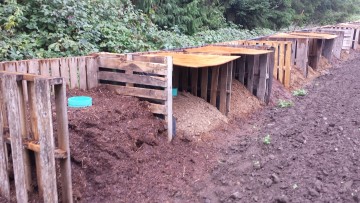Project Lead: Katarina Neufeld, Gabriel Maltais-Landry
Project Type: Contract
Supervisor: Dr. Sean Smukler
Project Partners: BC Ministry of Agriculture
Publications:
Research Overview
The SAL lab worked in partnership with the British Columbia Ministry of Agriculture (BCMOA) to develop a nutrient database for the Lower Fraser Valley and select regions of British Columbia. This database provides data on crop and manure nutrient values that are critical to improving the ease and accuracy of agricultural nutrient management planning. Crop and manure samples were taken and analyzed between 2013-2015.
One of the knowledge gaps found in the initial study was how nutrient availability of manure (especially poultry and horse manure) fluctuated due to storage time and condition. As a result, the SAL lab set up a controlled experiment to investigate how storage conditions (exposure to rain) and age of manure impact nutrient availability in chicken, turkey and horse manure.
The main objective of this project was to quantify changes in nutrient availability and GHG emissions from different manure piles (chicken, turkey, horse) that are protected or not from the rain. Chicken and turkey manures have a similar nitrogen (N) content as well as carbon (C) to N ratios (C:N), allowing us to determine the effects of relatively small changes in manure nutrient content and availability on nutrient cycling and GHG emissions. In contrast, poultry and horse manures have a very different nutrient content (much lower in horse) that allows us to determine how large changes in manure nutrient content affect decomposition rates, nutrient cycling, and GHG emissions. Finally, comparing manure piles that are protected or not from the rain allows us to identify benefits, if any, of storing manures in drier conditions in terms of nutrient retention and GHG fluxes.
Progress
E xperimental setup: A total of 18 manure piles (roughly 1 cubic yard each) were established at the UBC farm in August 2015 and were monitored until March 2016. Each treatment combination (manure type and rain protection) was replicated in three piles that are randomly allocated within three blocks.
xperimental setup: A total of 18 manure piles (roughly 1 cubic yard each) were established at the UBC farm in August 2015 and were monitored until March 2016. Each treatment combination (manure type and rain protection) was replicated in three piles that are randomly allocated within three blocks.
Data Collection: Changes in nutrient availability was monitored monthly by taking a 4.5cm core from each pile (frozen within 2 hours of collection and analyzed subsequently). GHG emissions – carbon dioxide (CO2), nitrous oxide (N2O), methane (CH4) – were quantified on a weekly basis, using cavity ring down spectroscopy.
Lab and data analysis: Manure samples were sent out to A&L Canada for nutrient analyses: total N, C:N and ammonium; total phosphorus and potassium; organic matter; calcium and magnesium. We also analyzed these manures with Fourier Transformed Infrared (FT-IR) spectroscopy (mid and near infrared) to develop a higher throughput and cheaper analytical approach to determine the nutrient content of manures.
Research Assistants
The following Land and Food Systems undergraduate students have assisted with this project:
- Judy Chang
- Joanna Cheng
- Mark Henry
- Amy Norgaard